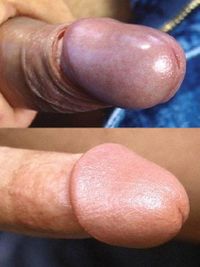Keratinisierung: Unterschied zwischen den Versionen
(Die Seite wurde neu angelegt: „{{NYT en}} {{GraphicWarning}} {{Baustelle}} Image:Keratinization_intact_vs_circumcised.JPG |thumbnail|right|200px| The glans and mucosa of intact and circumc…“) |
K (REFjournal uses <init> key) |
||
| (Eine dazwischenliegende Version desselben Benutzers wird nicht angezeigt) | |||
| Zeile 8: | Zeile 8: | ||
== Keratin as "Protection" == | == Keratin as "Protection" == | ||
| − | It was hypothesized in the past that the layers of keratin resulting from circumcision provided a barrier of protection against sexually transmitted diseases. In 1986, [[Aaron J. Fink]] invented the idea that circumcision could prevent the transmission of HIV, arguing that the hard and toughened glans of the circumcised male resisted infection, while the soft and sensitive foreskin and glans mucosa of the intact male were ports of entry.<ref>Fink | + | It was hypothesized in the past that the layers of keratin resulting from circumcision provided a barrier of protection against sexually transmitted diseases. In 1986, [[Aaron J. Fink]] invented the idea that circumcision could prevent the transmission of HIV, arguing that the hard and toughened glans of the circumcised male resisted infection, while the soft and sensitive foreskin and glans mucosa of the intact male were ports of entry.<ref>{{REFjournal |
| + | |last=Fink | ||
| + | |first=Aaron J. | ||
| + | |init=AJ | ||
| + | |author-link=Aaron J. Fink | ||
| + | |title=A possible Explanation for Heterosexual Male Infection with AIDS | ||
| + | |journal=New England Journal of Medicine | ||
| + | |volume=315 | ||
| + | |issue=18 | ||
| + | |date=1986 | ||
| + | |page=1167 | ||
| + | }}</ref> | ||
Recent studies have shown this hypothesis to be false. One study found that there is "no difference between the keratinization of the inner and outer aspects of the adult male foreskin," and that "keratin layers alone were unlikely to explain why uncircumcised men are at higher risk for HIV infection."<ref>{{REFjournal | Recent studies have shown this hypothesis to be false. One study found that there is "no difference between the keratinization of the inner and outer aspects of the adult male foreskin," and that "keratin layers alone were unlikely to explain why uncircumcised men are at higher risk for HIV infection."<ref>{{REFjournal | ||
|last=Dinh | |last=Dinh | ||
| − | | | + | |init=MH |
|last2=McRaven | |last2=McRaven | ||
| − | | | + | |init2=MD |
|last3=Kelley | |last3=Kelley | ||
| − | | | + | |init3=Z |
|last4=Penugonda | |last4=Penugonda | ||
| − | | | + | |init4=S |
|last5=Hope | |last5=Hope | ||
| − | | | + | |init5=TJ |
|title=Keratinization of the adult male foreskin and implications for male circumcision | |title=Keratinization of the adult male foreskin and implications for male circumcision | ||
|journal=AIDS | |journal=AIDS | ||
| Zeile 50: | Zeile 61: | ||
{{REF}} | {{REF}} | ||
| − | [[Kategorie: | + | [[Kategorie:Physiologie]] |
| − | [[Kategorie: | + | [[Kategorie:Penisstörungen]] |
[[Kategorie:Von Intactipedia]] | [[Kategorie:Von Intactipedia]] | ||
Aktuelle Version vom 28. November 2021, 12:22 Uhr
(Dieser Artikel wurde noch nicht aus dem Englischen übersetzt oder enthält noch englische Textpassagen. Bitte beziehe dich vorerst auf die Informationen im englischen Artikel. Klicke dazu in der IntactiWiki-Navigation im Abschnitt "In anderen Sprachen" auf "English".)
Baustelle
Dieser Artikel ist im Entstehen und noch nicht Bestandteil der freien Enzyklopädie IntactiWiki.
Keratinization is the process whereby the surface of the glans and remaining mucosa of the circumcised penis become dry, toughened and hard. Normally, the glans is covered by the foreskin, which moisturizes the area by transudation, keeping the surface of the glans and inner mucosa moist and supple. After circumcision, however, the glans and surrounding mucosa become permanently externalized, and they are exposed to the air and the constant abrasion of clothing. These areas dry out, causing layers of keratin to build, giving the glans and remaining mucosa a dry, leathery appearance and reducing sensation.
Keratin as "Protection"
It was hypothesized in the past that the layers of keratin resulting from circumcision provided a barrier of protection against sexually transmitted diseases. In 1986, Aaron J. Fink invented the idea that circumcision could prevent the transmission of HIV, arguing that the hard and toughened glans of the circumcised male resisted infection, while the soft and sensitive foreskin and glans mucosa of the intact male were ports of entry.[1]
Recent studies have shown this hypothesis to be false. One study found that there is "no difference between the keratinization of the inner and outer aspects of the adult male foreskin," and that "keratin layers alone were unlikely to explain why uncircumcised men are at higher risk for HIV infection."[2] Another study found that "no difference can be clearly visualized between the inner and outer foreskin." Be that as it may, this hypothesis continues to be popular among researchers who advocate for circumcision as STD prevention.
Higher incidence of HIV infection is found in circumcised men who lack the immunological protection of the foreskin and its Langerhans cells.
Einzelnachweise
- ↑
 Fink AJ. A possible Explanation for Heterosexual Male Infection with AIDS. New England Journal of Medicine. 1986; 315(18): 1167.
Fink AJ. A possible Explanation for Heterosexual Male Infection with AIDS. New England Journal of Medicine. 1986; 315(18): 1167.
- ↑
 Dinh MH, McRaven MD, Kelley Z, Penugonda S, Hope TJ. Keratinization of the adult male foreskin and implications for male circumcision. AIDS. 27. März 2010; 24(6): 899-906. PMID.
Dinh MH, McRaven MD, Kelley Z, Penugonda S, Hope TJ. Keratinization of the adult male foreskin and implications for male circumcision. AIDS. 27. März 2010; 24(6): 899-906. PMID.

